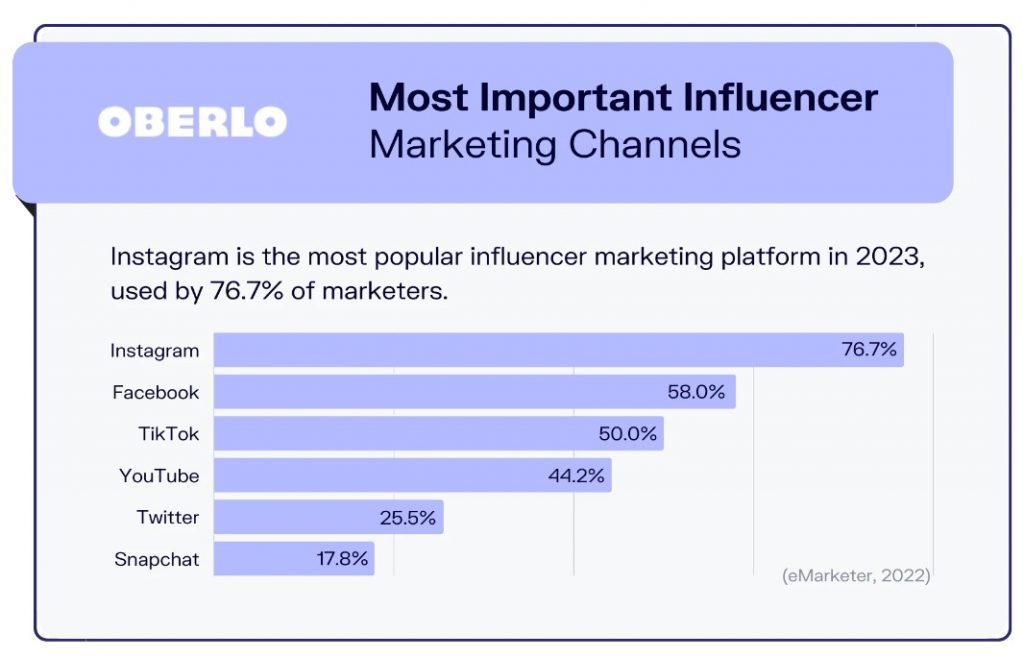What is an Influencer and what is influencer marketing?
Simply described, an influencer is a person with the ability to convince others. Usually, they enjoy a significant, loyal fan base that respects and cherishes their opinions. Working with well-known people who have sizable social media followings in order to promote a product, service, or brand is known as influencer marketing.
Influencer marketing can be used in a variety of ways, such as paid or sponsored articles, reviews, competitions, and endorsements. Brands frequently pay these influencers or provide them with free products or services in exchange for their endorsement.
Influencer marketing tries to increase brand awareness, increase brand trust, and eventually increase sales by utilizing influencers’ popularity and credibility. Due to the importance of social media in marketing and consumers’ rising cynicism about traditional advertising strategies, this type of marketing has grown more common.
Influencer Marketing Statistics
1. Influencer marketing has climbed to $16.4 billion in 2022. It was $13.8 billion in 2021.
2. For every $1 invested in influencer marketing, companies generate a return on investment of $5.2.
3. Since 2016, searches on Google alone for the term “influencer marketing” have increased by 465%.
4. Influencer marketing is regarded as an effective marketing strategy by 90% of study participants.
5. Instagram is used for influencer marketing by 67% of firms.
6. In the last five years alone, 1360 platforms and firms with an emphasis on influencer marketing have entered the market. (Source: Influencer Marketing Hub)
According to the size of their following, these are the three most typical categories of influencers:
1. Macro-influencers: Influencers with massive followings—typically 100,000 or more—on social media platforms are known as macro-influencers. They frequently have a large fan base and the ability to reach a wide audience since they are celebrities or social media influencers.
2. Micro-influencers: On social media platforms, these influencers often have a following of 1,000–100,000 people. They frequently target a certain niche and attract a more active and devoted following. Higher engagement rates may result from the perception that micro-influencers are more genuine and reliable.
3. Nano-influencers: Influencers with a following of less than 1,000 on social media platforms are known as nano-influencers. They frequently consist of regular people who are enthusiastic about a certain topic and who connect with their audience on a genuine level. Because they are frequently regarded as personable and reliable, nano-influencers have a greater chance of generating high levels of audience engagement.
The choice of which sort of influencer to work with relies on the goals, target audience, and budget of the brand. Each form of influencer has advantages and disadvantages of its own.
Benefits of influencer marketing:
1. Increased brand awareness: Collaboration with influencers can assist firms in reaching a wider audience and boosting brand recognition. In social media, influencers have a loyal following, and those users believe the advice they give.
2. Enhanced credibility: Influencers have developed a name for themselves and credibility within their specialized fields. Their followers are more inclined to believe and attempt what they advocate when they endorse a good or service.
3. Increased engagement: Influencer marketing may result in increased social media engagement. Influencers have an engaged following, and their followers are more likely to like, comment, and share their content.
4. Marketing with a specific audience in mind: Influencer marketing enables this. Businesses may be confident that their message is being heard by working with influencers whose followers belong to the same demographic or interest group as the target audience.
5. Cost-effectiveness: Using influencer marketing to advertise a good or service can be done affordably. Working with influencers frequently costs less than conventional marketing strategies like television or newspaper advertising.
6. Sales growth: Influencer marketing can help organizations experience sales growth. Influencers’ followers are more likely to make a purchase when they endorse a good or service, which boosts sales for the company.
Influencer marketing has some potential benefits for reaching a target demographic, but there are also some drawbacks. The following are some frequent problems that may occur in influencer marketing:
1. Inauthenticity: Influencer marketing may appear untrustworthy if the endorser does not firmly believe in the good or service they are promoting. This could undermine the influencer’s relationship with their followers and lower conversion rates as a result of a lack of trust.
2. Improper targeting: The campaign may fail to reach the target demographic if the brand does not carefully choose a suitable influencer to work with. A low return on investment, for instance, can result from working with an influencer who has a sizable following but whose audience does not fit the brand’s target market.
3. Oversaturation: As influencer marketing has grown in popularity, sponsored content has overtaken various social media platforms. Users may become less responsive to sponsored posts as a result, which might drop engagement levels and reduce the return on investment.
4. Lack of transparency: Influencers occasionally fail to acknowledge that their content is sponsored or that they have been paid to promote a product. Because of this, there may be a lack of trust between the influencer and their followers, which eventually harms the brand’s reputation.
5. Unrealistic expectations: Companies may have inflated hopes for an influencer marketing campaign’s success. For example, expecting an immediate increase in sales or a viral social media trend may not be realistic and can lead to disappointment and a lack of faith in influencer marketing as a whole.
Logicloop’s Roadmap for Influencer Marketing Success:
1. Choose and finalize an influencer depending on the profile and their content.
2. Get a contract signed with the influencer and had them shoot it as per the script.
3. Draft a script on the lines of the angle we would want to go with.
4. The influencer would send us the video that would only be sent for post-production after the client’s approval.
5. The final video is then posted on the influencer’s profile tagging us which we shall also repost on our wall.
6. We document & track the performance by keeping a tab on the follower count, engagement rate & reach.
Top Social Media Platforms for Influencer Marketing
According to a report by eMarketer in 2022, Instagram is the most favored social media platform for influencer marketing by brands, with 76.7% of marketers and agency professionals planning to include it in their strategies. Following Instagram is Facebook, with 58% of marketers planning to use it. TikTok has shown a massive increase in popularity, with 50% of marketers intending to use it for influencer marketing, a substantial rise from the 27% in 2019. Other popular platforms include YouTube, with 44.2%, and Twitter, with 25.5%. (Source: Oberlo)

The most common goals of influencer marketing campaigns are:
1. Increase brand awareness: Influencers can help brands reach new audiences and increase their brand visibility by sharing sponsored content with their followers.
2. Drive website traffic: Brands can use influencers to drive traffic to their website by including links in their sponsored content.
3. Boost sales: Influencers can help promote products or services and encourage their followers to make a purchase.
4. Increase social media followers: Brands can collaborate with influencers to reach new followers and grow their social media presence.
5. Enhance brand reputation: Influencers can help build a positive image of a brand by sharing positive experiences and highlighting the brand’s values and mission.
6. Launch a new product: Influencers can help generate buzz and excitement for new products by sharing sponsored content with their followers.
7. Improve engagement: Influencers can help increase engagement by creating content that resonates with their audience and encourages them to interact with the brand.
The goals of influencer marketing campaigns may vary depending on the brand’s objectives, target audience, and digital marketing strategy.



